The Ancient Varieties of Mountain Maize: The Inheritance of the Pointed Character and Its Effect on the Natural Drying Process
Abstract
1. Introduction
2. Materials and Methods
2.1. Plant Material
2.2. Outline Analysis of the Seeds
2.3. Complementation Test and Constitution of F2 Segregating Population for Pointed Seed Trait
2.4. Seed Air-Drying Modeling
2.5. The Effect of Pigmentation on the Surface Temperature of the Seeds
3. Results
3.1. Shape of Kernels
3.2. Inheritance of Pointed Trait
3.3. Seed Air-Drying Modeling
3.4. Surface Temperature of the Seeds
4. Discussion
5. Conclusions
Supplementary Materials
Author Contributions
Funding
Institutional Review Board Statement
Informed Consent Statement
Data Availability Statement
Acknowledgments
Conflicts of Interest
References
- FAO. Agricultural Biodiversity. Background Paper 1. FAO/Netherlands Conference of Multifunctional Character of Agriculture and Land. 1999. Available online: http://www.fao.org/mfcal/pdf/bp_1_agb.pdf (accessed on 11 April 2019).
- Jackson, L.; Pascual, U.; Hodgkin, T. Utilizing and conserving agrobiodiversity in agricultural landscapes. Agric. Ecosyst. Environ. 2007, 121, 196–210. [Google Scholar] [CrossRef]
- Esquinas-Alcázar, J. Protecting crop genetic diversity for food security: Political, ethical and technical challenges. Nat. Rev. Genet. 2005, 6, 946–953. [Google Scholar] [CrossRef] [PubMed]
- Giupponi, L.; Pilu, R.; Scarafoni, A.; Giorgi, A. Plant agro-biodiversity needs protection, study and promotion: Results of research conducted in Lombardy region (Northern Italy). Biodivers. Conserv. 2020, 29, 409–430. [Google Scholar] [CrossRef]
- Brandolini, A. Maize introduction, evolution and diffusion in Italy. Maydica 2009, 54, 233–242. [Google Scholar]
- Eurostat. Eurostat Crop Production in EU Standard Humidity by NUTS 2 Regions. 2018. Available online: http://appsso.eurostat.ec.europa.eu/ (accessed on 18 June 2018).
- Bertolini, M. Mais in Lombardia: Varietà Tradizionali. Istituto Sperimentale per la Cerealicoltura Sezione di Bergamo, Quaderni della Ricerca. 2002. Available online: https://docplayer.it/21766205-Mais-in-lombardia-varieta-tradizionali.html (accessed on 15 July 2021).
- Hammer, K.; Xhuveli, L.; Perrino, P. Estimating genetic erosion in landraces? two case studies. Genet. Resour. Crop. Evol. 1996, 43, 329–336. [Google Scholar] [CrossRef]
- McCouch, S.; Baute, G.J.; Bradeen, J.; Bramel, P.; Bretting, P.K.; Buckler, E.; Burke, J.M.; Charest, D.; Cloutier, S.; Cole, G.; et al. Feeding the future. Nature 2013, 499, 23–24. [Google Scholar] [CrossRef]
- Dyer, G.A.; López-Feldman, A.; Yúnez-Naude, A.; Taylor, J.E. Genetic erosion in maize’s center of origin. Proc. Natl. Acad. Sci. USA 2014, 111, 14094–14099. [Google Scholar] [CrossRef] [PubMed]
- Puglisi, D.; Landoni, M.; Cassani, E.; Toschi, I.; Lucchini, G.; Cesari, V.; Borlini, G.; Scapin, A.; Pilu, R. Traditional farmers’ varieties: A valuable source of genetic variability for biofortification programs. Maydica 2018, 63, 1–10. [Google Scholar]
- Villa, T.C.C.; Maxted, N.; Scholten, M.; Ford-Lloyd, B. Defining and identifying crop landraces. Plant Genet. Res. 2005, 3, 373–384. [Google Scholar] [CrossRef]
- Casañas, F.; Simó, J.; Casals, J.; Prohens, J. Toward an Evolved Concept of Landrace. Front. Plant Sci. 2017, 8, 145. [Google Scholar] [CrossRef] [PubMed]
- Spataro, G.; Negri, V. The European seed legislation on conservation varieties: Focus, implementation, present and future impact on landrace on farm conservation. Genet. Resour. Crop. Evol. 2013, 60, 2421–2430. [Google Scholar] [CrossRef]
- Santamaria, P.; Ronchi, L. Varietà da conservazione in Italia: Lo stato dell’arte per le specie orticole. Italus Hortus 2016, 23, 29–44. [Google Scholar]
- Negri, V. Agro-Biodiversity Conservation in Europe: Ethical Issues. J. Agric. Environ. Ethic 2005, 18, 3–25. [Google Scholar] [CrossRef]
- Fideghelli, C.; Engel, P. Biodiversity and local genetic resources: From knowledge to exploitation. Acta Hortic. 2009, 817, 295–310. [Google Scholar] [CrossRef]
- Frison, E.A.; Cherfas, J.; Hodgkin, T. Agricultural Biodiversity Is Essential for a Sustainable Improvement in Food and Nutrition Security. Sustainability 2011, 3, 238–253. [Google Scholar] [CrossRef]
- Giorgi, A.; Scheurer, T. Alpine Resources: Assets for a Promising Future—Conclusions from the ForumAlpinum 2014. Mt. Res. Dev. 2015, 35, 414–415. [Google Scholar] [CrossRef]
- Ceccarelli, S.; Grando, S.; Maatougui, M.; Michael, M.; Slash, M.; Haghparast, R.; Rahmanian, M.; Taheri, A.; Al-Yassin, A.; Benbelkacem, A.; et al. Plant breeding and climate changes. J. Agric. Sci. 2010, 148, 627–637. [Google Scholar] [CrossRef]
- Cassani, E.; Puglisi, D.; Cantaluppi, E.; Landoni, M.; Giupponi, L.; Giorgi, A.; Pilu, R. Genetic studies regarding the control of seed pigmentation of an ancient European pointed maize (Zea mays) rich in phlobaphenes: The “Nero Spinoso” from the Camonica valley. Genet. Resour. Crop Evol. 2017, 64, 761–773. [Google Scholar] [CrossRef]
- Giupponi, L.; Tamburini, A.; Giorgi, A. Prospects for Broader Cultivation and Commercialization of Copafam, a Local Variety ofPhaseolus coccineusL.; in the Brescia Pre-Alps. Mt. Res. Dev. 2018, 38, 24–34. [Google Scholar] [CrossRef]
- Giupponi, L.; Leoni, V.; Colombo, F.; Cassani, E.; Hejna, M.; Rossi, L.; Pilu, R. Characterization of “Mais delle Fiorine” (Zea mays L.) and nutritional, morphometric and genetic comparison with other maize landraces of Lombardy region (Northern Italy). Genet. Resour. Crop. Evol. 2021, 68, 2075–2091. [Google Scholar] [CrossRef]
- Landoni, M.V.; Andrea, S.; Cassani, E.; Borlini, G.; Follador, A.R.V.; Giupponi, L.; Ghidoli, M.; Hejna, M.; Rossi, L.; Pilu, S.R. Comparison among four maize varieties in conventional and low input cultivation. Maydica 2021, 65, 1–13. [Google Scholar]
- Landoni, M.; Puglisi, D.; Cassani, E.; Borlini, G.; Brunoldi, G.; Comaschi, C.; Pilu, R. Phlobaphenes modify pericarp thickness in maize and accumulation of the fumonisin mycotoxins. Sci. Rep. 2020, 10, 1–9. [Google Scholar] [CrossRef] [PubMed]
- Pilu, R.; Cassani, E.; Sirizzotti, A.; Petroni, K.; Tonelli, C.; Pilu, S.R. Effect of flavonoid pigments on the accumulation of fumonisin B1 in the maize kernel. J. Appl. Genet. 2010, 52, 145–152. [Google Scholar] [CrossRef] [PubMed]
- Sampietro, D.A.; Fauguel, C.M.; Vattuone, M.A.; Presello, D.A.; Catalan, C.A.N. Phenylpropanoids from maize pericarp: Resistance factors to kernel infection and fumonisin accumulation by Fusarium verticillioides. Eur. J. Plant Pathol. 2012, 135, 105–113. [Google Scholar] [CrossRef]
- Venturini, G.; Toffolatti, S.; Pilu, R.; Quaglino, F.; Casati, P. First report of fusarium temperatum causing ear rot on maize in italy. Plant Pathol. 2016, 98, 677–697. [Google Scholar]
- Venturini, G.; Babazadeh, L.; Casati, P.; Pilu, R.; Salomoni, D.; Toffolatti, S.L.; Pilu, S.R. Assessing pigmented pericarp of maize kernels as possible source of resistance to fusarium ear rot, Fusarium spp. infection and fumonisin accumulation. Int. J. Food Microbiol. 2016, 227, 56–62. [Google Scholar] [CrossRef]
- Toufektsian, M.-C.; De Lorgeril, M.; Nagy, N.; Salen, P.; Donati, M.B.; Giordano, L.; Mock, H.-P.; Peterek, S.; Matros, A.; Petroni, K.; et al. Chronic Dietary Intake of Plant-Derived Anthocyanins Protects the Rat Heart against Ischemia-Reperfusion Injury. J. Nutr. 2008, 138, 747–752. [Google Scholar] [CrossRef]
- Lago, C.; Landoni, M.; Cassani, E.; Doria, E.; Nielsen, E.; Pilu, R. Study and characterization of a novel functional food: Purple popcorn. Mol. Breed. 2013, 31, 575–585. [Google Scholar] [CrossRef]
- Lago, C.; Cassani, E.; Zanzi, C.; Landoni, M.; Trovato, R.; Pilu, R.; Pilu, S.R. Development and study of a maize cultivar rich in anthocyanins: Coloured polenta, a new functional food. Plant Breed. 2014, 133, 210–217. [Google Scholar] [CrossRef]
- Lago, C.; Landoni, M.; Cassani, E.; Cantaluppi, E.; Doria, E.; Nielsen, E.; Giorgi, A.; Pilu, R. Study and characterization of an ancient European flint white maize rich in anthocyanins: Millo Corvo from Galicia. PLoS ONE 2015, 10, e0126521. [Google Scholar]
- Ginwala, R.; Bhavsar, R.; Chigbu, D.G.I.; Jain, P.; Khan, Z.K. Potential Role of Flavonoids in Treating Chronic Inflammatory Diseases with a Special Focus on the Anti-Inflammatory Activity of Apigenin. Antioxidants 2019, 8, 35. [Google Scholar] [CrossRef] [PubMed]
- Mangelsdorf, P.C.; Reeves, R.G. The Origin of Corn: III. Modern Races, the Product of Teosinte Introgression. Bot. Mus. Leafl. Harv. Univ. 1959, 18, 389–411. [Google Scholar] [CrossRef]
- Kuhl, F.P.; Giardina, C.R. Elliptic Fourier features of a closed contour. Comput. Graph. Image Process. 1982, 18, 236–258. [Google Scholar] [CrossRef]
- Claude, J. Morphometrics with R; Springer: New York, NY, USA, 2008. [Google Scholar] [CrossRef]
- Bonhomme, V.; Picq, S.; Gaucherel, C.; Claude, J. Momocs: Outline Analysis Using R. J. Stat. Softw. 2014, 56, 1–24. [Google Scholar] [CrossRef]
- Bonhomme, V.; Forster, E.; Wallace, M.; Stillman, E.; Charles, M.; Jones, G. Identification of inter- and intra-species variation in cereal grains through geometric morphometric analysis, and its resilience under experimental charring. J. Archaeol. Sci. 2017, 86, 60–67. [Google Scholar] [CrossRef]
- R Core Team. R: A Language and Environment for Statistical Computing; R Foundation for Statistical Computing: Vienna, Austria, 2009; Available online: http://www.R-project.org (accessed on 15 July 2021).
- Giupponi, L.; Giorgi, A. Effectiveness of modern leaf analysis tools for the morpho-ecological study of plants: The case of Primula albenensis Banfi et Ferl. Nord. J. Bot. 2019, 37, e02386. [Google Scholar]
- Giupponi, L.; Leoni, V.; Pedrali, D.; Ceciliani, G.; Bassoli, A.; Borgonovo, G. Morphometric and phytochemical characterization and elevation effect on yield of three potato landraces of the Ligurian Apennines (Northern Italy). J. Appl. Bot. Food Qual. 2020, 93, 234–243. [Google Scholar]
- Brewster, M.Q. Water Evaporation and Condensation in Air With Radiation: The Self-Similar Spalding Model. J. Heat Transf. 2017, 139, 081501. [Google Scholar] [CrossRef]
- Verma, R.C.; Prasad, S. Mechanical and thermal properties of maize. J. Food Sci. Technol. 2000, 37, 500–505. [Google Scholar]
- Matsuoka, Y.; Vigouroux, Y.; Goodman, M.M.; Sanchez, J.; Buckler, E.; Doebley, J. A single domestication for maize shown by multilocus microsatellite genotyping. Proc. Natl. Acad. Sci. USA 2002, 99, 6080–6084. [Google Scholar] [CrossRef] [PubMed]
- Mir, C.; Zerjal, T.; Combes, V.; Dumas, F.; Madur, D.; Bedoya, C.; Dreisigacker, S.; Franco, J.; Grudloyma, P.; Hao, P.X.; et al. Out of America: Tracing the genetic footprints of the global diffusion of maize. Theor. Appl. Genet. 2013, 126, 2671–2682. [Google Scholar] [CrossRef] [PubMed]
- Vigouroux, Y.; Glaubitz, J.C.; Matsuoka, Y.; Goodman, M.M.; Sánchez, G.J.; Doebley, J. Population structure and genetic diversity of New World maize races assessed by DNA microsatellites. Am. J. Bot. 2008, 95, 1240–1253. [Google Scholar] [CrossRef] [PubMed]
- Warburton, M.L.; Reif, J.C.; Frisch, M.; Bohn, M.; Bedoya, C.; Xia, X.C.; Crossa, J.; Franco, J.; Hoisington, D.; Pixley, K.; et al. Genetic Diversity in CIMMYT Nontemperate Maize Germplasm: Landraces, Open Pollinated Varieties, and Inbred Lines. Crop. Sci. 2008, 48, 617–624. [Google Scholar] [CrossRef]
- Rodríguez, V.M.; Soengas, P.; Landa, A.; Ordás, A.; Revilla, P. Effects of selection for color intensity on antioxidant capacity in maize (Zea mays L.). Euphytica 2013, 193, 339–345. [Google Scholar] [CrossRef][Green Version]
- Casas, M.; Duarte, S.; Doseff, A.I.; Grotewold, E. Flavone-rich maize: An opportunity to improve the nutritional value of an important commodity crop. Front. Plant Sci. 2014, 5. [Google Scholar] [CrossRef] [PubMed]
- Lago, C.; Landoni, M.; Cassani, E.; Atanassiu, S.; Cantaluppi, E.; Pilu, R. Development and characterization of a coloured sweet corn line as a new functional food. Maydica 2014, 59, 191–200. [Google Scholar]
- Petroni, K.; Pilu, R.; Tonelli, C. Anthocyanins in corn: A wealth of genes for human health. Planta 2014, 240, 901–911. [Google Scholar] [CrossRef] [PubMed]
- Ardenghi, N.M.G.; Rossi, G.; Guzzon, F. Back to beaked: Zea mays subsp. mays Rostrata Group in northern Italy, refugia and revival of open-pollinated maize landraces in an intensive cropping system. PeerJ 2018, 6, e5123. [Google Scholar] [CrossRef] [PubMed]
- Stagnati, L.; Martino, M.; Soffritti, G.; Lanubile, A.; Ravasio, A.; Marocco, A.; Rossi, G.; Busconi, M. Microsatellite and morphological characterization of three Rostrato di Val Chiavenna (Sondrio, Italy) maize (Zea mays L.) accessions. Genet. Resour. Crop. Evol. 2021, 68, 3025–3038. [Google Scholar] [CrossRef]
- Román, F.; Mbuge, D.O.; Hensel, O. Modeling the effect of a superabsorbent polymer material as desiccant in maize drying using CFD. Dry. Technol. 2019, 37, 1441–1453. [Google Scholar] [CrossRef]
- Azmir, J.; Hou, Q.; Yu, A. Discrete particle simulation of food grain drying in a fluidised bed. Powder Technol. 2018, 323, 238–249. [Google Scholar] [CrossRef]
- Janas, S.; Boutry, S.; Malumba, P.; Elst, L.V.; Béra, F. Modelling dehydration and quality degradation of maize during fluidized-bed drying. J. Food Eng. 2010, 100, 527–534. [Google Scholar] [CrossRef]
- Sanghi, A.; Ambrose, R.P.K.; Maier, D. CFD simulation of corn drying in a natural convection solar dryer. Dry. Technol. 2017, 36, 859–870. [Google Scholar] [CrossRef]
- Malekjani, N.; Jafari, S.M. Simulation of food drying processes by Computational Fluid Dynamics (CFD); recent advances and approaches. Trends Food Sci. Technol. 2018, 78, 206–223. [Google Scholar] [CrossRef]
- Neményi, M.; Czaba, I.; Kovács, A.; Jáni, T. Investigation of simultaneous heat and mass transfer within the maize kernels during drying. Comput. Electron. Agric. 2000, 26, 123–135. [Google Scholar] [CrossRef]
- Skarbø, K.; VanderMolen, K. Maize migration: Key crop expands to higher altitudes under climate change in the Andes. Clim. Dev. 2015, 8, 245–255. [Google Scholar] [CrossRef]
- Brandolini, A.; Landi, P.; Monfredini, G.; Tano, F. Variation among Andean races of maize for cold tolerance during heterotrophic and early autotrophic growth. Euphytica 2000, 111, 33–41. [Google Scholar] [CrossRef]
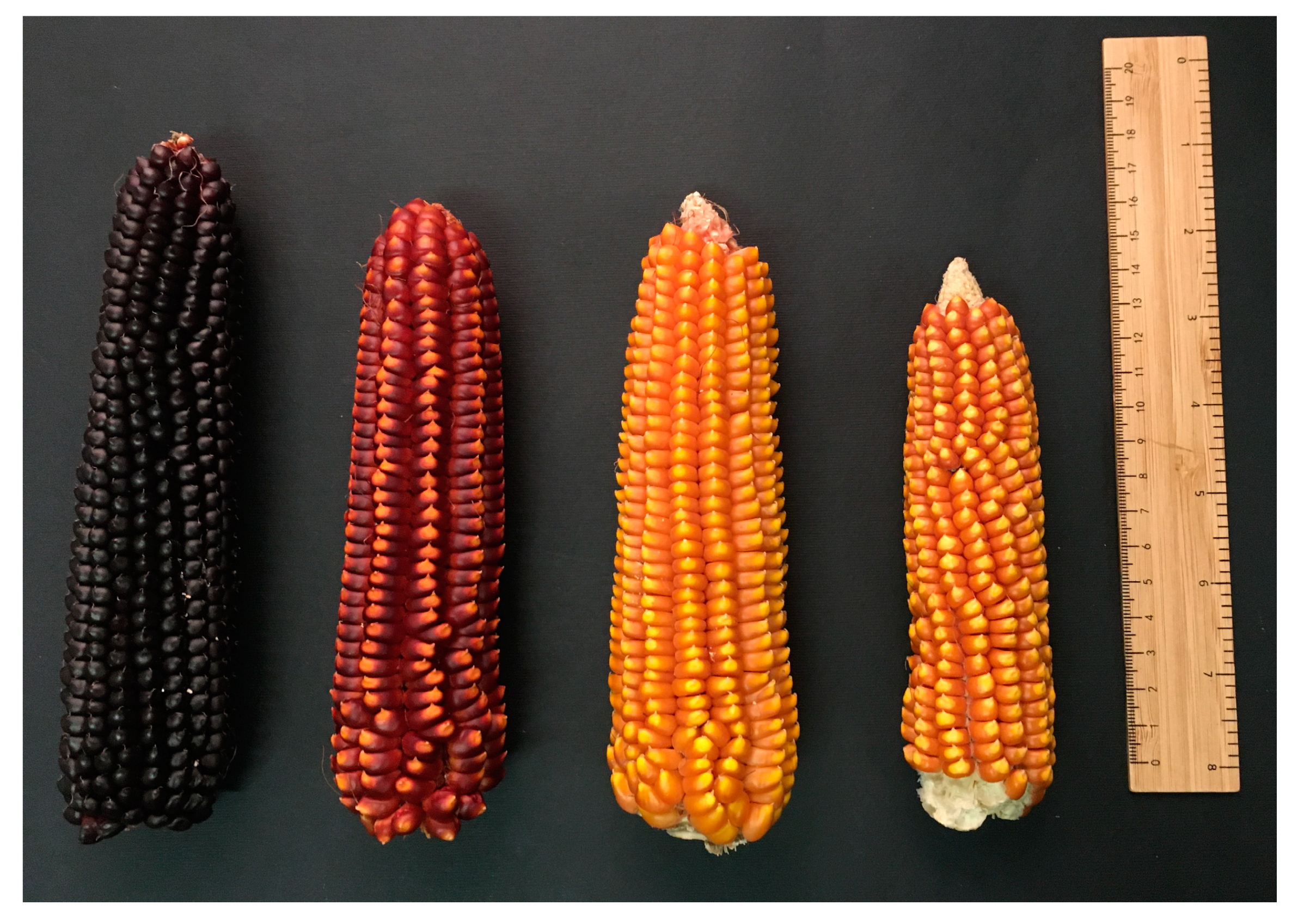
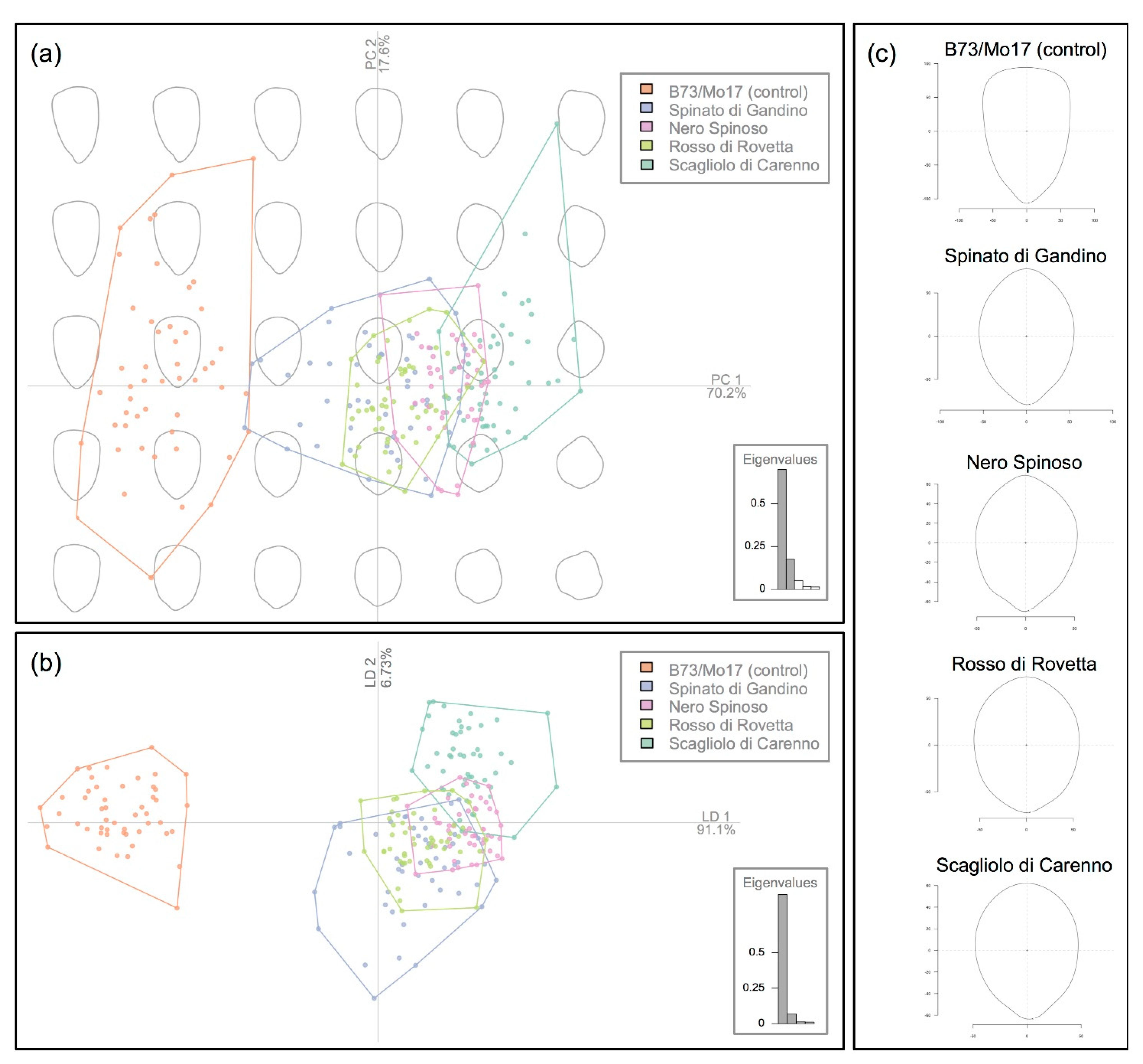
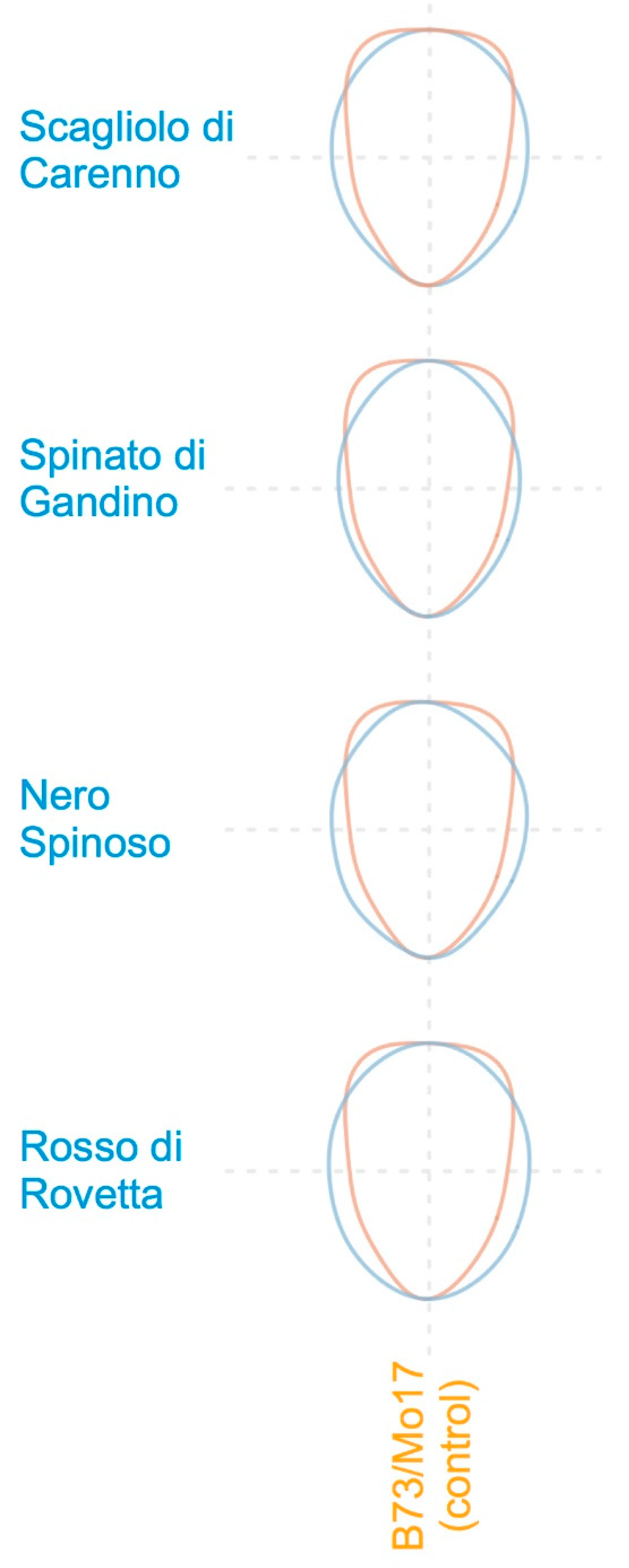
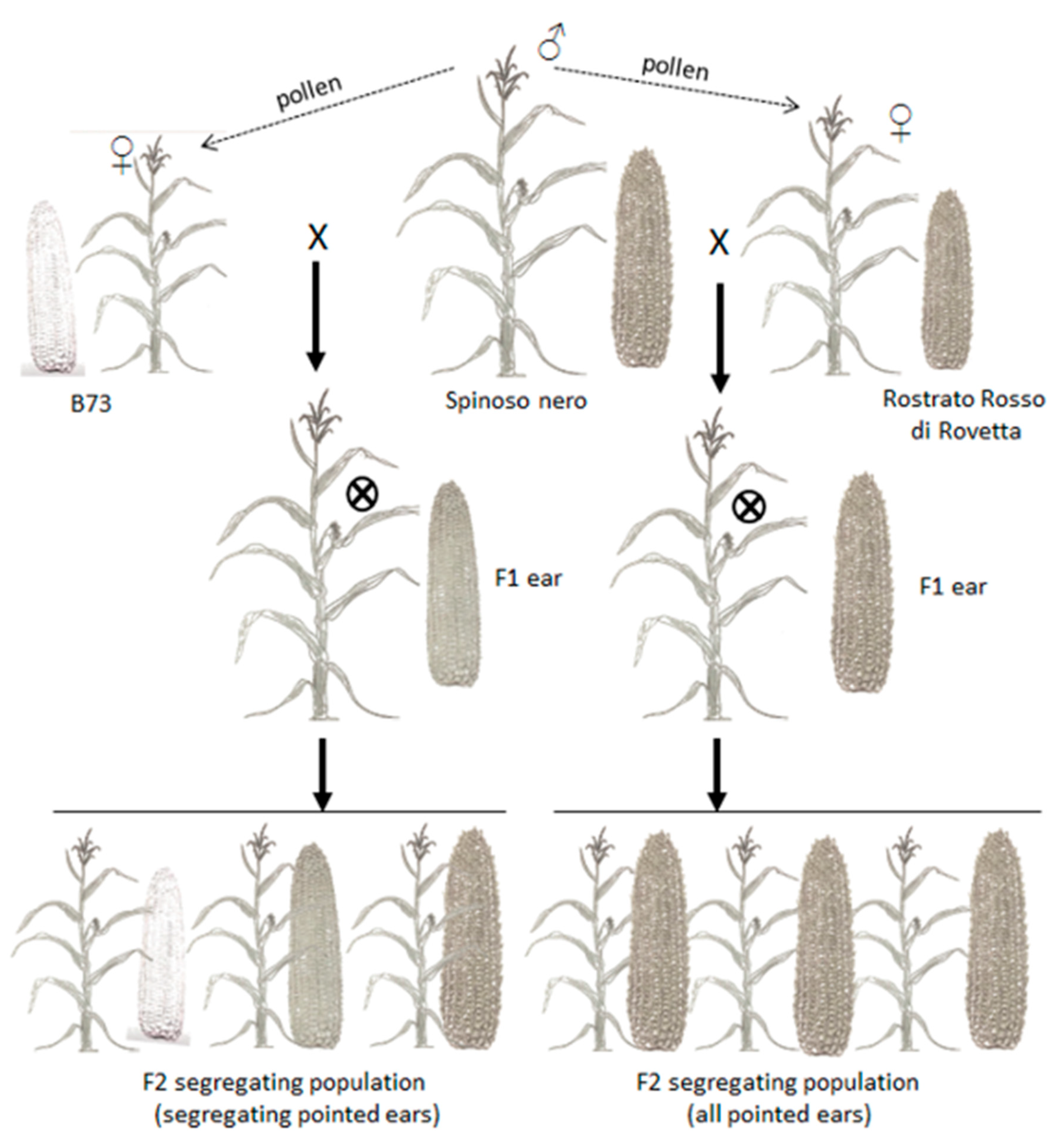

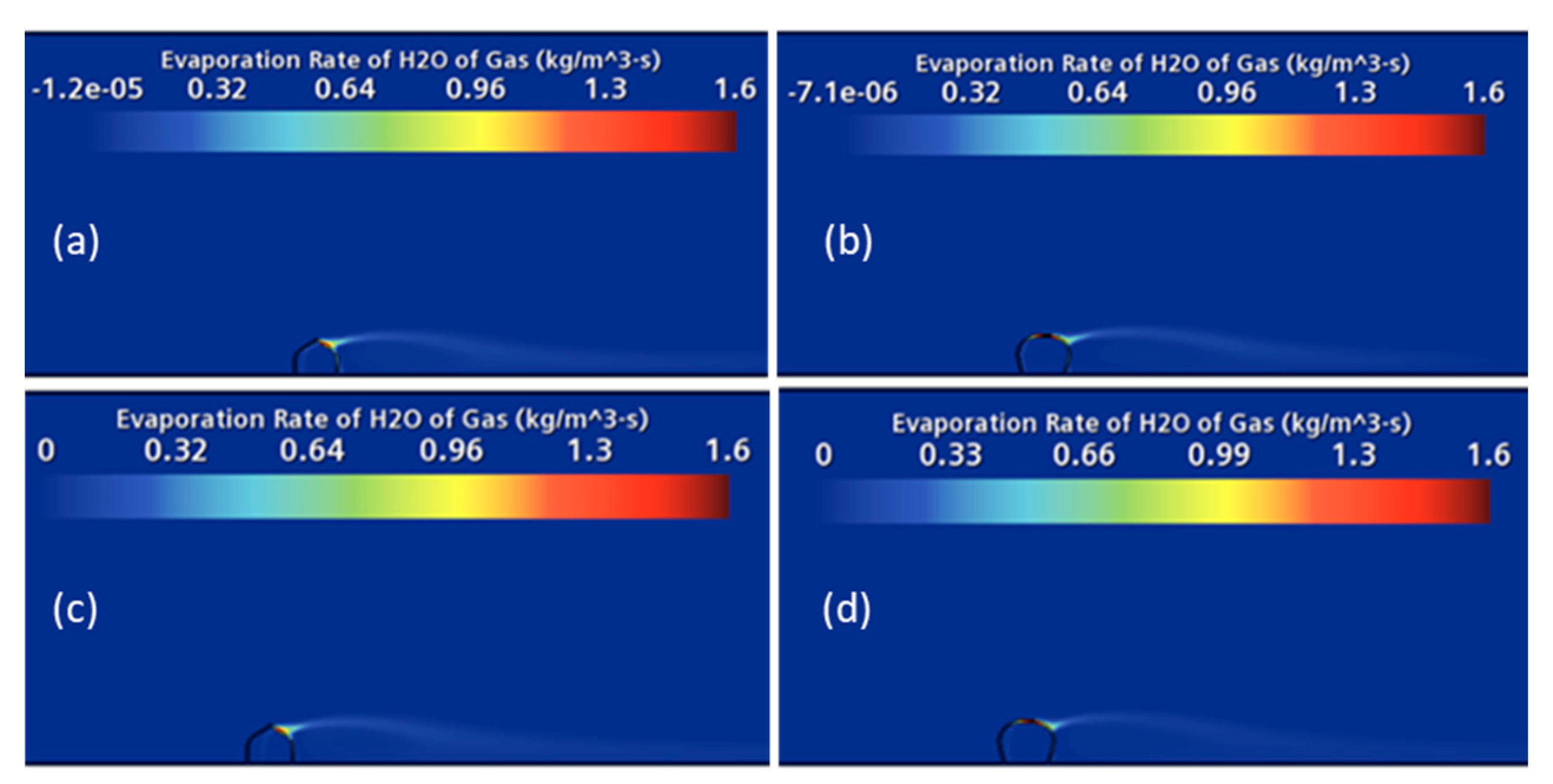
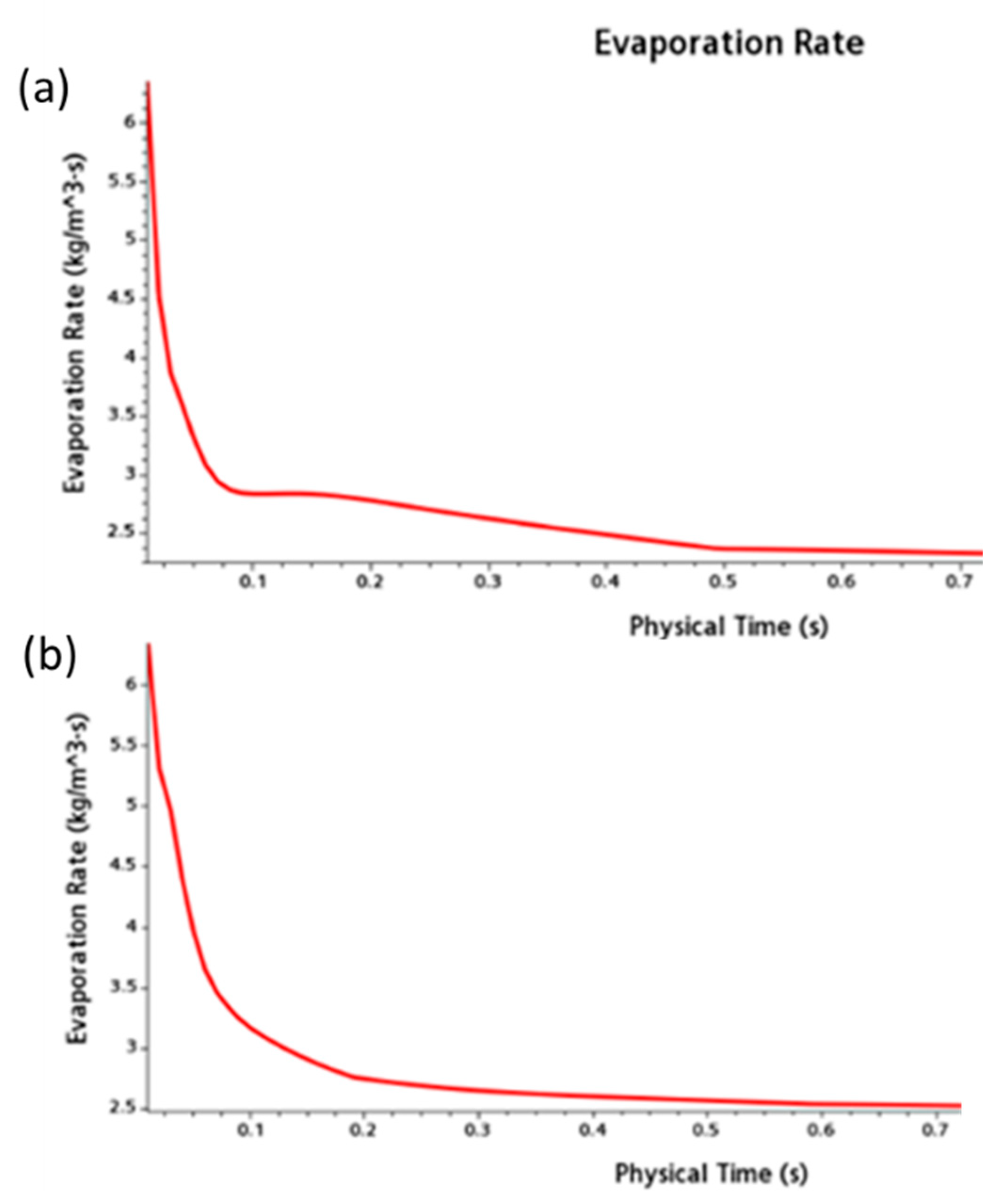

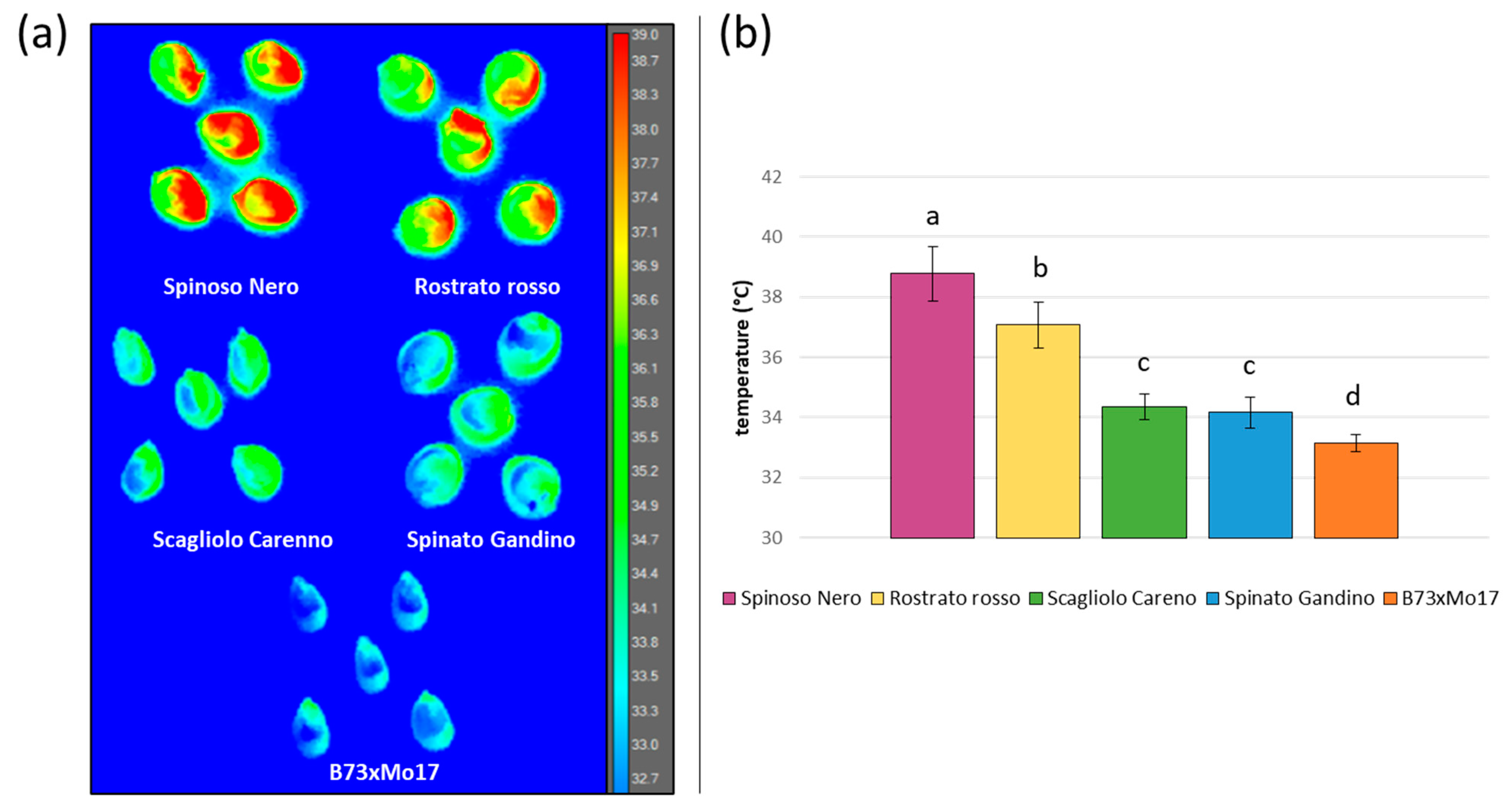
| Pointed | Moderately Pointed | Slightly Pointed | Not Pointed | Total | χ2 (1:16) | χ2 (1:64) | |
|---|---|---|---|---|---|---|---|
| nr ears | 6 | 86 | 80 | 11 | 183 | 2.76 | 3.5 |
Publisher’s Note: MDPI stays neutral with regard to jurisdictional claims in published maps and institutional affiliations. |
© 2021 by the authors. Licensee MDPI, Basel, Switzerland. This article is an open access article distributed under the terms and conditions of the Creative Commons Attribution (CC BY) license (https://creativecommons.org/licenses/by/4.0/).
Share and Cite
Sangiorgio, S.; Colombo, F.; Ghidoli, M.; Giupponi, L.; Ferro, G.; Ferro, C.G.; Cassani, E.; Landoni, M.; Pilu, R. The Ancient Varieties of Mountain Maize: The Inheritance of the Pointed Character and Its Effect on the Natural Drying Process. Agronomy 2021, 11, 2295. https://doi.org/10.3390/agronomy11112295
Sangiorgio S, Colombo F, Ghidoli M, Giupponi L, Ferro G, Ferro CG, Cassani E, Landoni M, Pilu R. The Ancient Varieties of Mountain Maize: The Inheritance of the Pointed Character and Its Effect on the Natural Drying Process. Agronomy. 2021; 11(11):2295. https://doi.org/10.3390/agronomy11112295
Chicago/Turabian StyleSangiorgio, Stefano, Federico Colombo, Martina Ghidoli, Luca Giupponi, Giulio Ferro, Carlo Giovanni Ferro, Elena Cassani, Michela Landoni, and Roberto Pilu. 2021. "The Ancient Varieties of Mountain Maize: The Inheritance of the Pointed Character and Its Effect on the Natural Drying Process" Agronomy 11, no. 11: 2295. https://doi.org/10.3390/agronomy11112295
APA StyleSangiorgio, S., Colombo, F., Ghidoli, M., Giupponi, L., Ferro, G., Ferro, C. G., Cassani, E., Landoni, M., & Pilu, R. (2021). The Ancient Varieties of Mountain Maize: The Inheritance of the Pointed Character and Its Effect on the Natural Drying Process. Agronomy, 11(11), 2295. https://doi.org/10.3390/agronomy11112295













